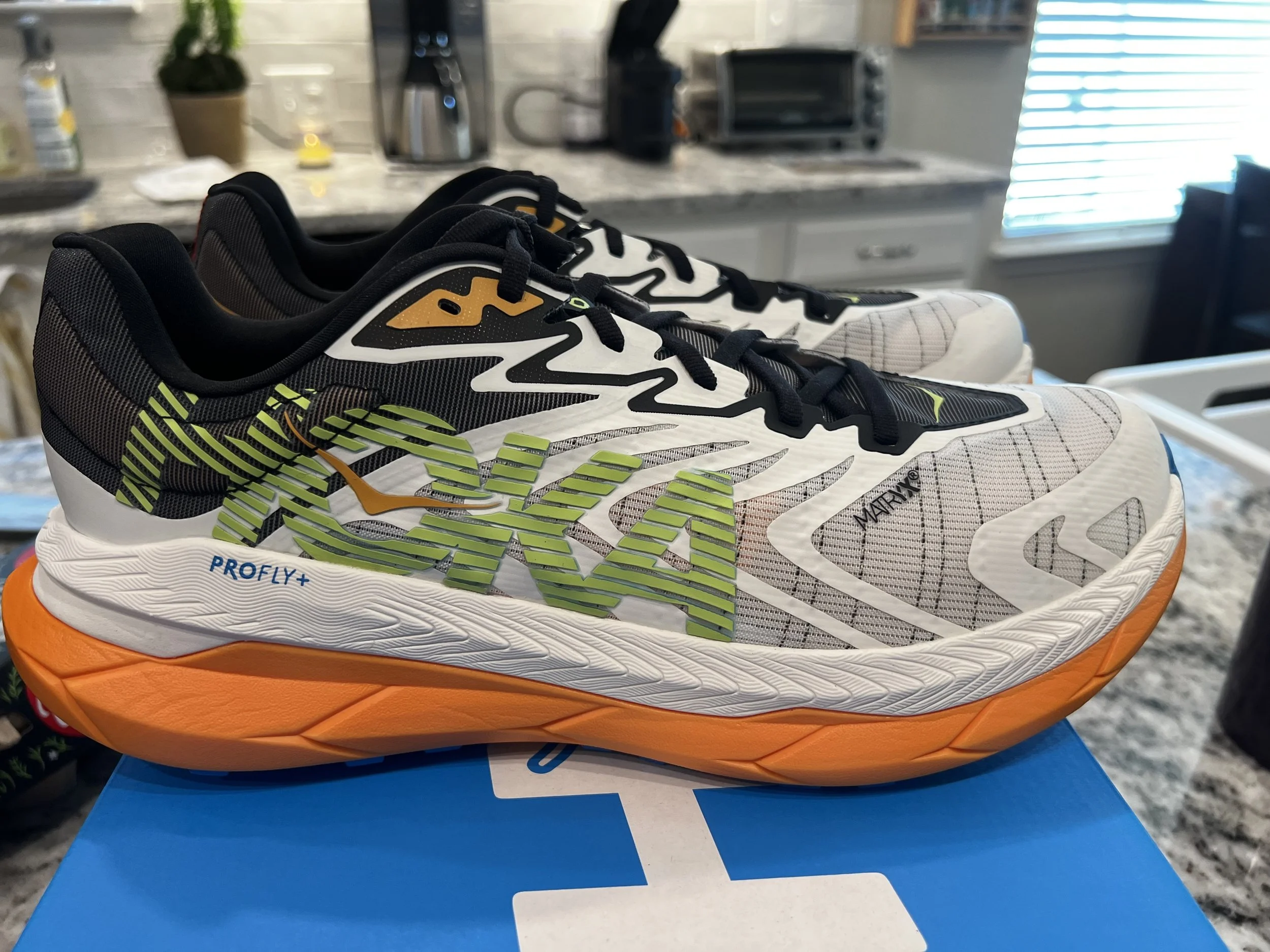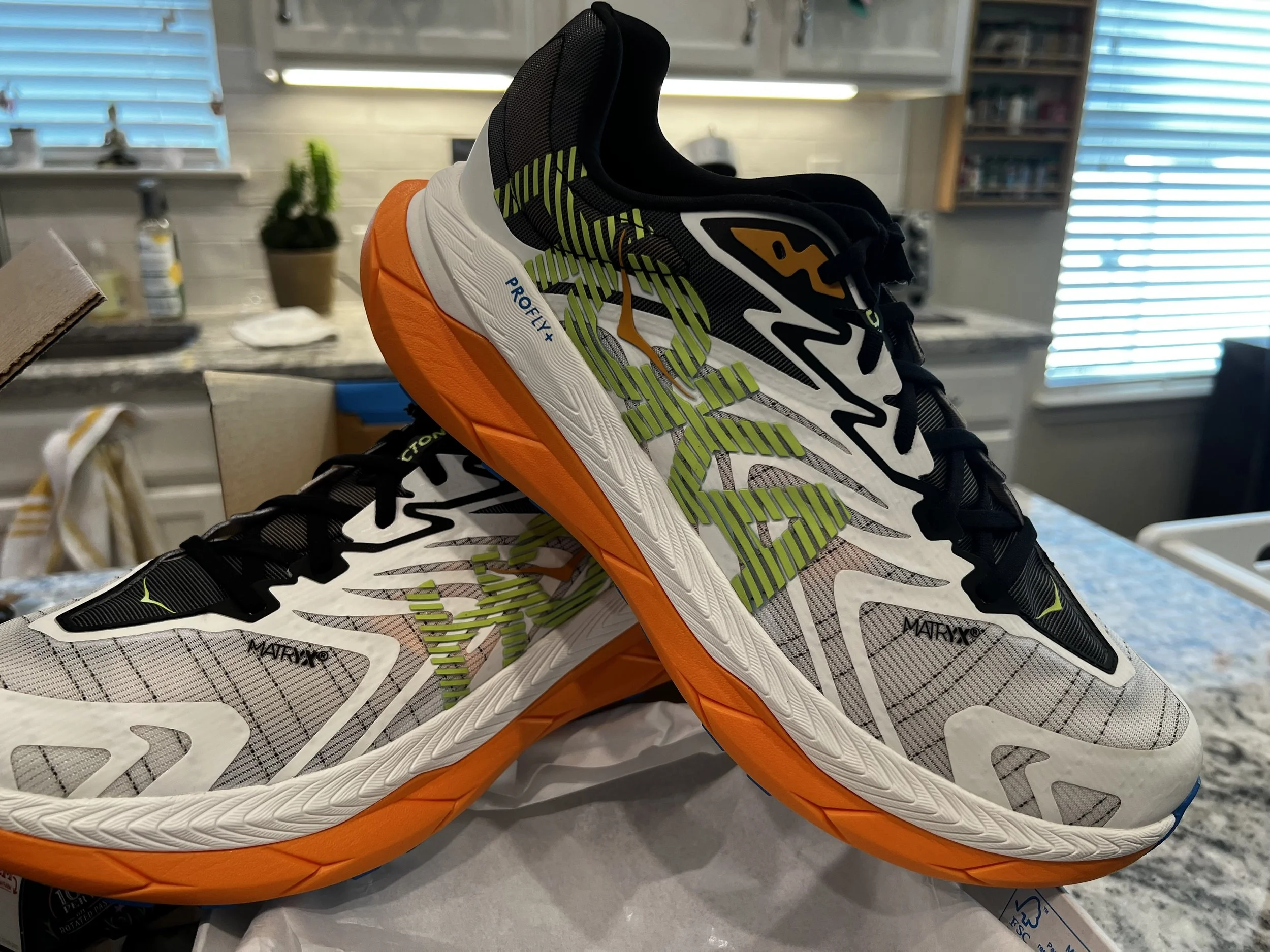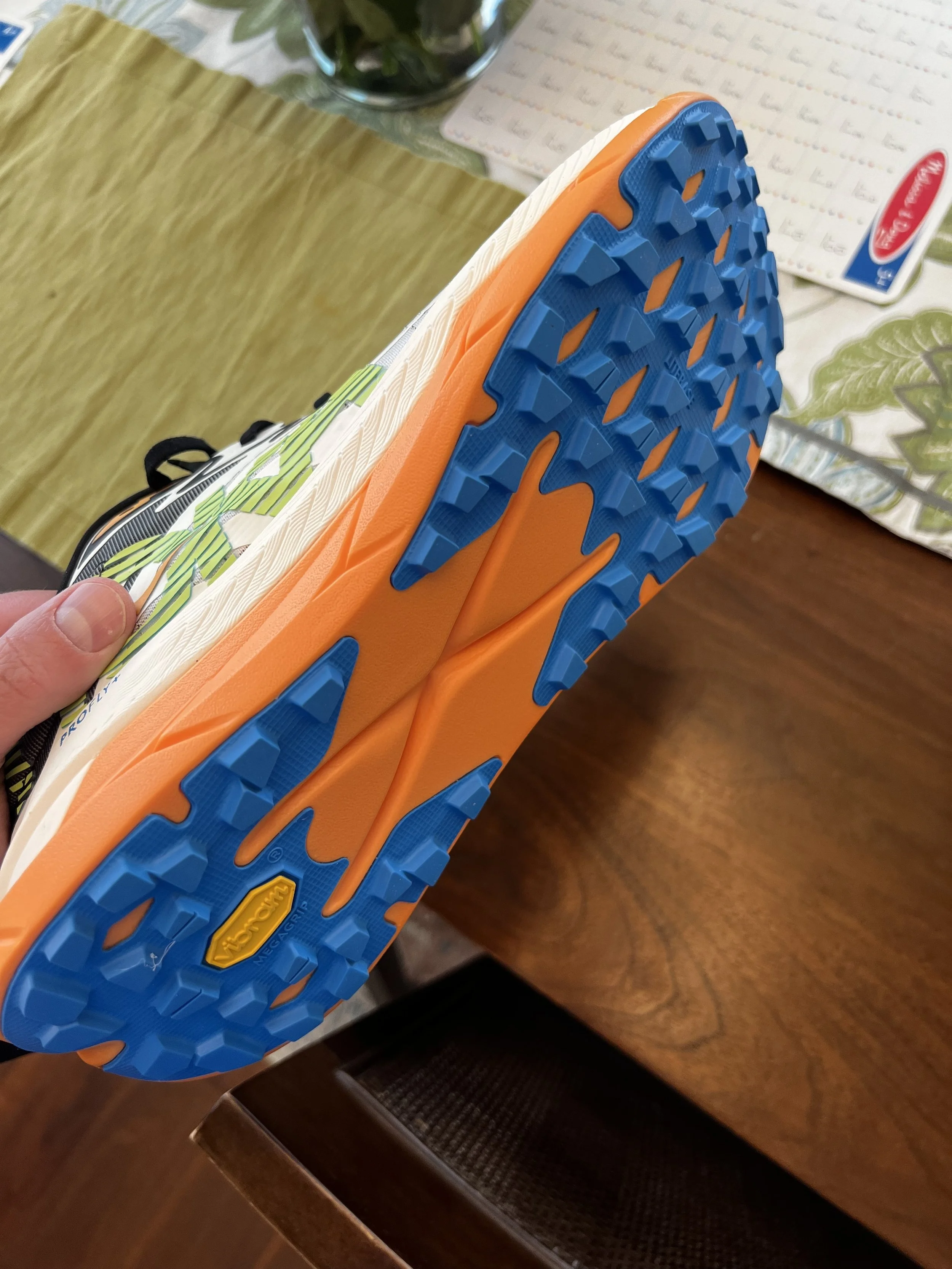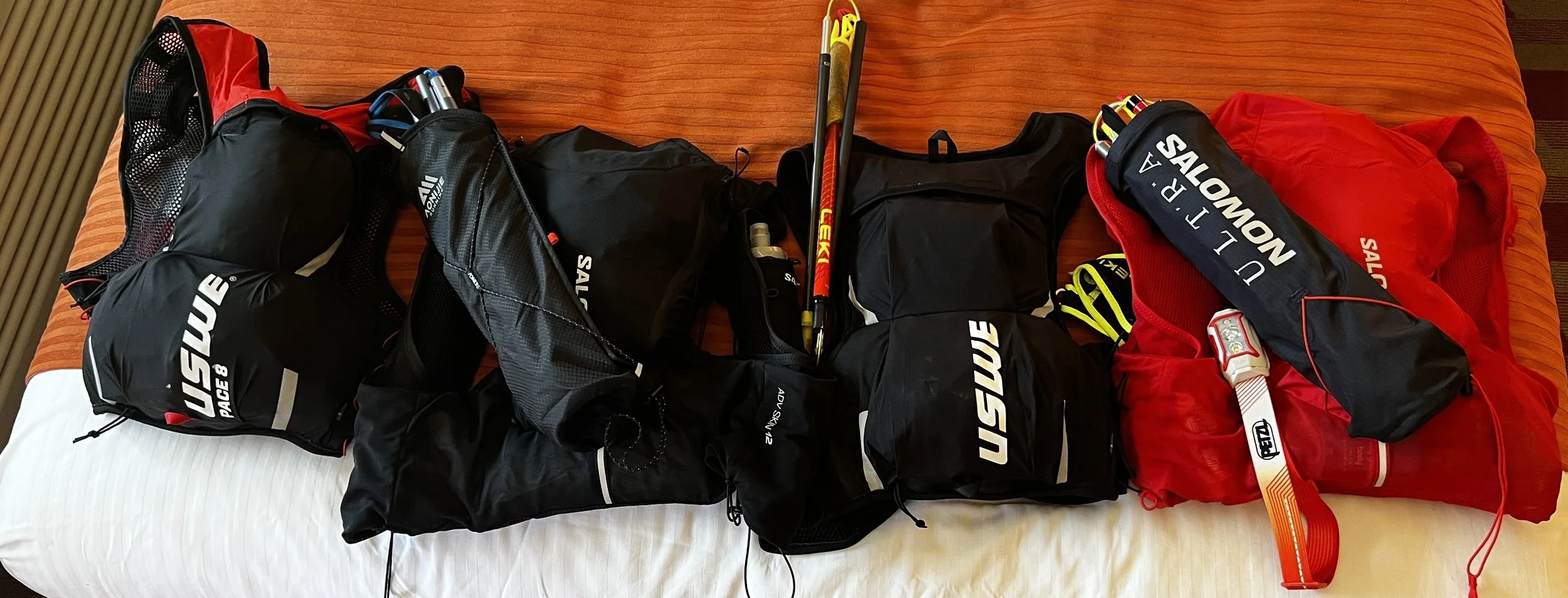My Gear
Doing R3 is a really big deal. Not only are you going to be running and hiking some rugged terrain, but the availability of water, food, shelter, shade, etc. is pretty sparse, so you really need to plan your gear deliberately.
Let me walk you through what I had, how it worked for me and what I learned about what I might need if (actually when) I do this beast again.
The Quick List:
Shoes: HOKA Tecton X2 (road training in HOKA Mach X)
Socks: Smartwool Zero Cushion Half Crew
Shorts: Patagonia Strider Pro Shorts - 5”
Shirt: Nike Dri-Fit T-Shirt
Nike Running Arm Sleeves
Buff neck gator
Hat: Ciele GOCap (shout out to BPN edition - Go One More!)
Sunglasses: Oakley Holbrook
Headlamp: Petzl Actik Core
Running Pack: Salomon ADV Skin 12
Poles: Leki Ultratrail FX.One
Pole Carry: Salomon Ultra Quiver
Hydration: Salomon 0.5L soft flasks (x2) and Salomon soft flask XA filter
Nutrition: GU Gels, Honey Stinger Waffles, Clif Bars, Trail Mix, Freeze Dried Apples
Electrolytes: Liquid IV, Scratch Labs, Tailwind
My Highlights:
Shoes:
I have a pretty bad case of hallux rigidus in my big toes, so I was looking for some trail running shoes that had carbon plates so that it could support the flexion in my toes and also offer some protection from the rocks of the trail. I ended up buying the HOKA Tecton X2. As soon as I put them on, I was sold. They are super comfortable. Springy soft foam, nice return from the carbon plates and a lower stack height so I wasn’t worried about rolling my ankle (like many other HOKA shoes). The first pair I got, however, were a lemon, so I had to get another pair, which made me a bit nervous that they wouldn’t hold up on the trail. This worry proved to be unfounded.
I ran in them for a couple of my long runs, 12 and 15 miles, and after those runs I had sore calves and started getting a blister on one. I live in Austin, TX, so it’s hot and it’s humid, which means I sweat a ton and I think that was really the source of the blister, but I got this blister in the first week of taper so I was a little nervous about using these shoes for the full 50 miles on the trail. So, probably unwisely, at the last minute I went to find another shoe option for the trail and try to break them in fast.
I really love HOKA running shoes, so I stuck with them in my search. The other guys all had Speedgoats, so I tried on the Speedgoat 6 and found it super uncomfortable. The foam was really hard and they looked terrible as well, but most importantly, they were not comfortable like you’d expect from HOKA. I then tried on the Challenger ATR 7, which felt really nice. I got a pair of those, but only had a couple days to try to break them in before the run. I ran in them a couple times, did a side-by-side compare and ultimately decided that I’d stick with the Tecton X2.
It was the best choice I could have made. These are amazing shoes. In the end, I didn’t have a single blister. They were super comfortable through the whole run. They provided great comfort, energy return, rock protection and softness and they had just the right amount of tread. I never felt like I was slipping or couldn’t get a good foothold anywhere. The only thing that did get me a few times was sharp rocks hitting the top of my foot through the upper, but this would probably happen with any shoe you use. I highly recommend these shoes.
Running Pack and Quiver
The Salomon ADV Skin 12 was amazing, especially supplemented with the quiver for my poles. This pack is super comfortable and has way more storage than it seems. There are pockets everywhere, and I made use of every one. I especially loved how well the quiver fit in the back, which made my poles super accessible.
One other thing that was a surprise was that the quiver turned out to be a great carrier for my third soft flask. We only planned to use two soft flasks, but I brought the XA flask just in case we would need to take water out of the river along the way. Turned out to be really helpful because it was 105° in the heat of the day. As a result, as soon as we got to Cottonwood Campground, I filled up the XA flask as a spare and kept it in the quiver. I drank it on every stretch, so that was awesome to have and the quiver made it really accessible. This obviously only works when I had my poles out, but from Cottonwood on, I mostly used them so it worked out.
All the packs. Mine is the one on the right with the Salomon ADV Skin 12 and quiver holding my Leki UltratrailFX.one poles. Great set up!
Arm Sleeves and Neck Buff:
Finally, the two other things I really loved having were the neck gator (I had Buff brand) and the arm sleeves. I knew I was going to use the neck gator from very early on to give me sun protection, but the arm sleeves were a late add. I originally planned to wear a long sleeve shirt from Patagonia but it was so warm that I figured it would be nice to be able to shed the sleeves as the day got hotter if I wanted. Turns out that you still probably want the cover from the sun, but being able to remove the sleeves quickly and soak them in cold river water was clutch for staying cool when the temperatures reached 105° down in the canyon during the day. I soaked anything I could, especially on the last hike out. My sleeves, my hat, my neck gator. It all helped a ton.
Poles:
I’ve never run with poles before so I didn’t really know how I would like them. We all decided that they would be useful and if you watch any videos of Ultra Marathoners, you know that they are a staple. That said, I still wasn’t sure how much I would use mine.
Wow, did I underestimate how valuable they are. From the very beginning on our way down the Bright Angel Trail at 3:15am in the pitch black, headlamps on, they were essential. Running downhill is tough, especially on dark, uneven, rocky terrain. And when that terrain is a trail that’s next to a cliff, the stakes of falling are pretty high. Having the poles on this downhill was amazing for helping me plant stabilizing points and take the load off my feet, ankles and legs, as well as ensure I would not fall to the side off the trails.
Going up the hills, they were also critical, taking a lot of stress off the quads and helping give me a little extra boost up the hills. These trails are filled with steps, some very large, as well as water diversion stones that mean a lot of up and down steps. Having poles to be able to plant before or after those steps was an amazing way to help ease the impact of having to jump up and down all the time. After using poles for this run, I’m sold on them.
I used the Leki Ultratrail FX.One, which were really awesome. They had this strange glove system where there’s a little loop on the glove in between your thumb and pointer finger that locks into the top of the pole (they call it the “shark system”). At first I thought that I’d be looking pretty silly wearing these gloves all day, but after realizing how easy it was to clip in and out of the poles with those, I was sold. They also provided really good stable support, which I thought was better than what you get from the standard straps on other poles. They were a little more pricey than other options, but 100% worth it. And the side benefit is that your hands get some extra sun protection.
Thoughts on Other Items:
There were a lot of people out there with shoe gators. Let me just say this is completely unnecessary. First of all, they look super uncomfortable, and I think the whole goal was to keep dust and rocks out of your shoes. This was never an issue for me. Yes, there was some amount of dust/sand that got in my shoes, but not anything I could actually feel. I wore half crew socks, which were good enough to keep things away and absorb dust and dirt so it didn’t fall into the top of my shoe, but shoe gators are completely unnecessary.
The other thing a lot of people had were gigantic backpacks. I’m sure some people were out there hiking to camp, and in those cases, it makes sense, but for most of us it was a day hike and in that case staying light is really valuable. Now, we did a lot of running, so we were getting from water station to water station fairly quickly relative to those that were hiking, but I would argue if you have more than a 14-20 L bag, you’re overtaxing yourself. I think for most people a 14L bag with a 2L bladder and an extra 1L Nalgene would be perfect. Keep it light and mobile would be my suggestion.
Finally, make sure you have first aid supplies. We took a fairly pared down kit, but we still had the essentials, like a tourniquet, bleed stop, sutures, bandages and sterile wipes, etc. None of us have health issues, so we didn’t need any other medical items, but we did run across some other groups on the way out where someone was diabetic and didn’t bring sufficient insulin. The hike is no joke and will definitely take you longer than you think, so if you have any health considerations, make sure you are thoroughly prepared to manage for 25%-50% more time on the trail than you think.




